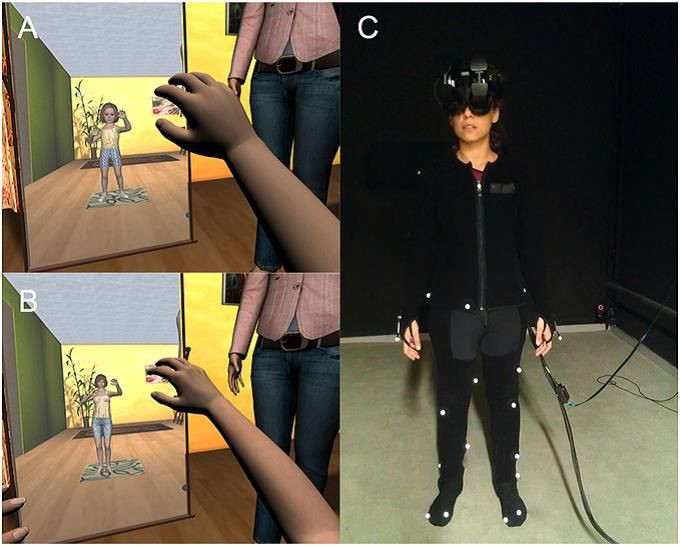Virtual Reality Changes Behavior And Perception, As Adults Experience World Through Child's Body [VIDEO]

The types of avatars people choose online may not only reflect their personalities but also influence their behavior, a new study suggests.
In a virtual simulation, adult participants assuming either the virtual identity of a child or a smaller-scaled adult overstimated the sizes of objects and experienced attitudinal changes while under the illusion. With synchronicity between visual and motor stimulation, the participants gained a first-person perspective within their new identity in the simulation, reporting a sense of "ownership" of their non-corporeal selves.
Half of the participants, 30 in the first of two experiements, assumed the virtual identity of a four-year-old child while the other half transmogrified into smaller-scaled adults of similar proportion. The methodology was built on previous experiements synchronizing real and virtual senses to create illusion, such as the sense of ownership gained from the well-known "rubber hand illusion," whereby participants identify with a mannequin's body.
However, a multidiciplinary international team of researchers showed for the first time in the study that the form of the virtual body — its proportionality of head size, trunk, and limbs — may influence the brain's perceptions of size in the external world, as well as reaction time. While study participants experiencing both virtual bodies reported feeling owership, the ones acting virtually as a four-year-old greatly overestimated the sizing of objects in real space, much more so than the smaller-scale adults.
"In our study, we concentrated on manipulating soley the bodily self-representation and on the consequences of this in subsequent perception and attitudes," the researchers wrote. "No external factors, such as social interaction, were present, and participants were alone rather than in social settings. Furthermore, this study is innovative in the way that takes into acount the virtual representation in a body of a different age — a child — and on the consquences of such a transformation on behavior and attitudes."
The study results supported the idea that synchronicity of multisensory simulation, some real and some imagined, would not only affect identity but also modify motor responses toward externalities. But the form of that propoportionately altered virtual body mattered even more.
In the second experiment of the study, researchers repeated the two conditions of the first scenario but desynchronized the visual and motor stimulation, effectively extinguishing the ownership illusion for 46 study participants assigned to virtual bodies of either the four-year-old child or smaller-scale adult. With the illusory bubble popped, the participants accurately estimated the sizing and distance of objects within their environment.
Although a previous study suggested that modifying body scale would change proportional prospective, the researchers went a bit further by showing that not size but experience as a child affected perception. Aside from "body size influencing the estimation of the sizes of objects in the environvent, there must be an additional underlying mechanism relating to perception of the form of the owned body," the researchers wrote. "The findings support the notion that higher-level cognitive processes... can influence our perceptual interpretation of sizes of objects in the external world other than body size alone."
In essence, the study shows that the visual appearance of the avatar one chooses in virtual reality greatly impacts one's self-perceptions while in the illusion, temporarily changing perceptions and behaviors from the mind to suit the new identity.
Below is video describing the notorious "rubber hand illusion":
Source: Banakoua DB, Grotena RC, Slater M. Illusory Ownership Of A Virtual Child Body Causes Overestimation Of Object Sizes And Implicit Attitude. PNAS. 2013.
Published by Medicaldaily.com



























